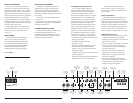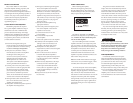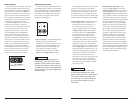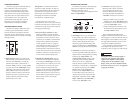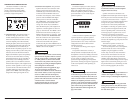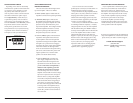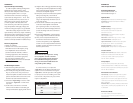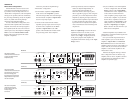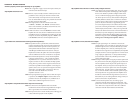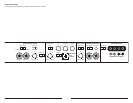
12 | JL Audio - 1000/1v2 Owner’s Manual
13
If you are unsure as to the cause of the
problem, please consult your JL Audio dealer or a
qualified automotive electrical specialist.
Keep in mind that any large amplifier, like the
1000/1, places a very heavy demand on a vehicle’s
charging system when operated at its limits.
Vehicles with weak charging systems may need
to be serviced and/or upgraded to provide ample
current to a system including a 1000/1.
There is only one condition that will shut down
BOVOEBNBHFEWDPNQMFUFMZy*GCBUUFSZ
voltage drops below 10 volts, the entire amplifier
XJMMTIVUJUTFMGPGG5IFHSFFOiPowerwJOEJDBUPS
on the top of the amplifier will turn off when this
occurs. The amplifier will turn back on when
voltage climbs back above 10 volts. This may
happen in a rapid cycle when bass-heavy program
material causes a weak charging system to dip
below 10 volts momentarily. If this is happening
in your system, have your charging system
inspected to make sure it is working properly.
For information on troubleshooting this
amplifier, refer to Appendix E (page 21).
SERVICING YOUR JL AUDIO AMPLIFIER
If your amplifier fails or malfunctions, please
SFUVSOJUUPZPVSBVUIPSJ[FE+-"VEJPEFBMFSTP
that it may be sent in to JL Audio for service.
There are no user serviceable parts or fuses inside
the amplifier. The unique nature of the circuitry
in the JL Audio amplifiers requires specifically
USBJOFETFSWJDFQFSTPOOFM%POPUBUUFNQU
to service the amplifier yourself or through
VOBVUIPSJ[FESFQBJSGBDJMJUJFT5IJTXJMMOPUPOMZ
void the warranty, but may result in the creation
of more problems within the amplifier.
If you have any questions about the installation or
setup of the amplifier not covered in this manual,
please contact your dealer or technical support.
JL Audio Technical Support:
(954) 443-1100
9:00 AM – 5:30 PM (Eastern Time Zone)
Monday - Friday
OUTPUT POLARITY SWITCH
%FQFOEJOHPOUIFEJTUBODFSFMBUJPOTIJQ
of the mid-bass speakers and the subwoofers
in a system, it can be desirable to reverse
the polarity of the subwoofer system in
order to produce a better transition between
subwoofer and mid-bass speaker output.
5IFiOutput PolaritywTXJUDIBMMPXTZPV
to peform this polarity inversion without
removing any wires. Simply flip the switch
GSPNUIFiNormalwUPUIFiReversedwQPTJUJPO
Experiment with this switch to determine
which polarity produces the best overall
bass performance in your system, listening
in particular to the mid-bass smoothness
and impact to make your determination.
Subwoofer Output
MONO OUTPUT ONLY
Output Polarity
Normal
|
Reversed
STATUS INDICATOR LIGHTS /
PROTECTION CIRCUITRY
There are three status indicator lights on the
top of the amplifier. These are as follows:
1)iPowerw (Green): lights to indicate that the
amplifier is turned on and operating normally.
2) i Thermalw (Red): lights to indicate that
the amplifier has exceeded its safe operating
temperature, putting the amplifier into a self-
protection mode, which reduces the power
output of the amplifier. The red light will shut
off and the amplifier will return to normal,
full-power operating mode if the heat sink
temperature drops back to a safe level.
3) iLow Ωw (Amber): lights to indicate that the
impedance of the speaker load connected
to the amplifier is lower than the optimum
impedance load range for the amplifier. When
this light is on, a protection circuit engages
and reduces the power output of the amplifier.
The amber indicator will also light when a
short-circuit is detected in the speaker wiring
(this can be a short between the positive and
negative speaker wires or between either
speaker wire and the vehicle chassis).
4) “Low V” (Blue): lights to indicate any
dip in supply voltage below 8 volts. The
CMVF-&%XJMMSFNBJOMJUMPOHFSUIBOUIF
dip duration to better alert the user to the
problem. This will be accompanied by a
shutdown of the amplifier (green LED
will shut off) and a total loss of output.
Once the voltage rises above 9 volts, the
amplifier will turn itself on. Because voltage
dips occur in rapid succession, the typical
behavior will be a cycling of the amplifier
on and off, accompanied by flashing of the
“Low V”CMVF-&%*GUIJTJTIBQQFOJOHJO
your system, you will need to investigate
the cause of the voltage problem. This could
be a bad ground on the amplifier, battery
or alternator OR a faulty battery/charging
system OR a problem with a fuse holder or
wire connection.




